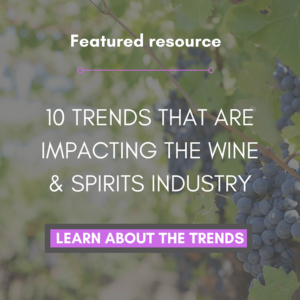The holiday season is always a crucial time for wine and spirits sales. A large portion of annual earnings are made during the last couple months of the year. But this holiday season is shaping up to be especially important for beverage wholesalers, whose profit margins have been thin this year because of the pandemic. The cost of keeping inventory is at a particularly high point at the moment, making it risky to take on too much product at once. However, retailers also don’t want to risk running out of stock while the holidays are still going on. With consumers’ buying habits having changed so much this year, it can be difficult to assess how much inventory to carry, and which products to focus on. Luckily, by paying attention to the data, we can make informed decisions about how best to manage stock.
Where products are being sold is important
It’s no surprise that on-premise alcohol sales are down this year. While bars and restaurants are finally starting to open back up, the expected bump from this returning base of customers has not been as significant as previously expected. While plenty of patrons have been coming back to their favorite establishments and ordering drinks, a lot of people are still understandably cautious about taking the risk of going out. However it seems that those customers are still drinking at home, since sales at liquor stores have remained strong all year. Online orders and delivery have been the fastest-growing sector of the wine and spirits market this year, and will likely play an important part in the upcoming holiday season. Liquor stores should make sure they have an accessible avenue for online purchasing that their customers are aware of. Otherwise, they could be giving a lot of their potential sales to their competitors. While less money is made from each transaction that goes through a third-party delivery service, it can be a great way to reach new customers and keep inventory moving.
Which products are being sold is important
The pandemic has changed more than just where customers are going to get their alcohol; it also had a major effect on what they are purchasing. There is a noticeable trend of customers this year gravitating towards well-known brands and products that they are familiar with, especially when they are shopping in-store or online. People tend to splurge and order more adventurously when dining out, so the lull in bar and restaurant patronage is likely causing fewer people to order adventurously. It could also be that with times being so uncertain, customers feel safer going with a brand they already know they’ll enjoy. Liquor wholesalers should focus on these established brands.
Seasonal items like peppermint schnapps, gingerbread vodka, and eggnog are riskier prospects since they are more difficult to get rid of after the holidays. Because of the rising inventory costs, carrying these is not recommended this year. With that being said, those products should already be packaged and getting ready to sell. Liquor wholesalers carrying these items should consider featuring them prominently in store displays (and on online ordering pages), to ensure that most of them get sold before the year ends.
But COVID-19 isn’t the only disaster that is affecting wine and spirits sales patterns in 2020. The ongoing wildfires on the west coast of the U.S. are set to have a profound effect on the wine industry. Portions of these fires reached the Napa and Sonoma valleys, both known for being some of the biggest producers of wine in America. While not many vineyards were directly in the path of the flames, there is major concern that smoke damage could have ruined this year’s grape crops. It is still unclear what long-term impact this will have on the wine business, but for now it seems to actually be boosting sales of California wines. Whether it is to show support or to speculate on the future availability of wine from the region, wines made on the west coast are currently experiencing a sales bump.
How data can help
Trends in the beverage alcohol industry fluctuate rapidly, and are heavily dependent on seasons, region, and location. The only way to keep your bearings in the constantly-changing landscape is with reliable data tracking. Dimensional Insight’s Inventory Advisor tool offers an easy way for wholesalers to monitor their supply and compare it to their sales goals, letting them know at a glance which products to focus on and keep in stock. The Inventory Advisor is also able to track order rates, and highlight any ‘dead’ products that should be removed from inventory as soon as possible. This vastly simplifies the inventory management process so that beverage alcohol retailers can keep flexible inventories that change along with consumer preferences to maximize profits.
Read more interesting reports like this one in Dimensional Insight’s Monthly Newsletter.
- Managing Time-Sensitive Inventory During the Holiday Season - December 8, 2020



